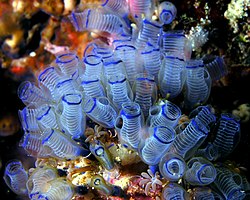Tunicate
Tunicates (sea squirts or Urochordata) are a subphylum of the Chordates.
| Tunicata | |
|---|---|

| |
| Sea tulips, Pyura spinifera. A symbiotic sponge covers its surface. | |
| Scientific classification | |
| Kingdom: | |
| Phylum: | |
| Subphylum: | Tunicata Giribet et al 2000
|



They are sea filter-feeders: they live mainly on plankton. They are called tunicates because the adult form is covered by a leathery tunic. This tunic supports and protects the animal. The adults are sessile, stuck to rocks.
Many tunicates are colonial or semi-colonial in their adult stage. They are quite a large group, containing about 3,000 species. The adults live mostly on the sea floor, in the littoral zone.
Feeding
changeThe sea squirt has two openings in its small body. One opening, called the oral siphon, sucks water into the animal; the other opening, called the atrial siphon, squirts water out of the animal. Inside is a little basket-like sieve which traps food: so these sea squirts are filter feeders. The Sea squirt can close the holes in its siphons, like a drawstring can close the opening in a bag.
Life cycle
changeWhen in its larval state, it looks like a tadpole and is sometimes called a tadpole larva. Like many sea creatures, a sea squirt larva looks very different from an adult sea squirt. The larva swims for a short time and then attaches itself to something on the sea floor, like a rock, transforming into its adult form. It usually stays in one place for the rest of its life.
Relationships
changeTunicates are more closely related to craniates (hagfish, lampreys, jawed vertebrates) than to lancelets, echinoderms, hemichordates, or other invertebrates.[1][2][3]
Discoveries
changeChemical substances which might help fight diseases like cancer or various viruses have been found in some species.
Scientists have also found out that some species can heal some damage done to them, over several generations. A similar process might be possible for humans.[4]
Related pages
change- Salp: these are noticed in the Southern Ocean near Antarctica. Their huge swarms may outnumber the krill.
References
change- ↑ Delsuc F., Brinkmann H., Chourrout D. & Philippe H. (2006). "Tunicates and not cephalochordates are the closest living relatives of vertebrates" (PDF). Nature. 439 (7079): 965–968. doi:10.1038/nature04336. PMID 16495997. S2CID 4382758.
{{cite journal}}: CS1 maint: multiple names: authors list (link) - ↑ Delsuc F., Tsagkogeorga G., Lartillot N. & Philippe H. (2008). "Additional molecular support for the new chordate phylogeny" (PDF). Genesis. 46 (11): 592–604. doi:10.1002/dvg.20450. PMID 19003928. S2CID 205771088.
{{cite journal}}: CS1 maint: multiple names: authors list (link) - ↑ Singh T. R., Tsagkogeorga G., Delsuc F., Blanquart S., Shenkar N., Loya Y., Douzery E. J. & Huchon D. (2009). "Tunicate mitogenomics and phylogenetics: peculiarities of the Herdmania momus mitochondrial genome and support for the new chordate phylogeny". BMC Genomics. 10 (1): 534. doi:10.1186/1471-2164-10-534. PMC 2785839. PMID 19922605.
{{cite journal}}: CS1 maint: multiple names: authors list (link) - ↑ Sea Squirt, heal thyself: scientists make major breakthrough in regenerative medicine
- Solomon E. Berg L. & Martin D. 2002. Biology. Brooks/Cole.